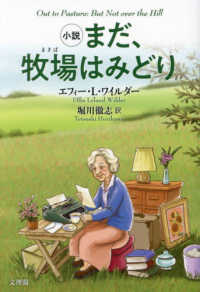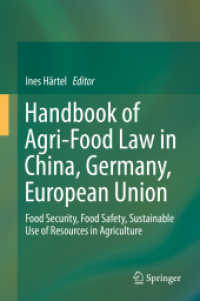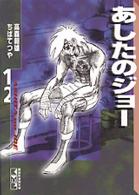- ホーム
- > 洋書
- > 英文書
- > Psychology
Full Description
Arminda Aberastury's Theory and Technique of Child Analysis contains a selection of original chapters written by Arminda Aberastury that are each accompanied by a commentary from leading contemporary child analysts to show the continuing global relevance of Arminda's mid-century work in Argentina. The commentaries are written by authors from all over the world, namely Minnie Dastur, Judith Edwards, Jeanne Magagna, Elizabeth Palacios, Joaquín Pichon-Rivière, Nydia Lisman Pieczanski, Jill Savege Scharff, David E. Scharff, Lea Sofer de Setton, Alan Sugarman, and Virginia Ungar. The book is further enriched by an editorial introduction, Foreword by Virginia Ungar, and personal reminiscences from Arminda's son, Joaquín Pichon-Rivière.
Arminda is a woman whose voice needs to be heard. She was at the forefront of developing child psychoanalysis in Argentina and created an interdisciplinary approach that influenced other professionals working with children in fields as diverse as pediatrics, pediatric dentistry, law, and education. The impact of her work spread to all over Latin America. This book demonstrates her growth as a child analyst, moving from a Freudian perspective closer to a Kleinian view of the stages of infant development, assisted by her correspondence with Melanie Klein. Within, she provides a summary of Anna Freud and Melanie Klein's approaches to child analysis and examples of her own continuing research throughout her career. The book is packed full of interesting theoretical concepts and case studies that detail her clinical technique and demonstrate her sensitivity and compassion in her work with children. It is illustrated with black and white photographs of Arminda and line drawings from her work.
Jill Savege Scharff and Lea Sofer de Setton have performed a profound service to the field of child psychoanalysis by bringing Arminda Aberastury to a whole new audience. Her work will inspire a whole new generation of child psychoanalysts and other professionals working with children.
Contents
List of illustrations
Editors' note and acknowledgments
About the editors and contributors
Foreword by Virginia Ungar
Arminda Aberastury, my mother: A personal reminiscence by Joaquín Pichon-Rivière
Author's preliminary note
Author's prologue
Part I - History of psychoanalytic technique
Analysis of the phobia of a five-year-old boy
Commentary by David E. Scharff (USA)
Birth of a technique
Commentary by Lea Sofer de Setton (Panama)
Two streams in child psychoanalysis: Anna Freud and Melanie Klein
Commentary by Judith Edwards (UK)
The development of psychoanalysis for children in Argentina
Commentary by Virginia Ungar (Argentina)
Part II - Technique in child analytic practice
Initial interview with the parents
Commentary by Nydia Lisman Pieczanski (Argentina and USA)
The office, the play material, the individual drawer, and technical problems arising from daily management
Commentary by Jill Savege Scharff (USA)
The meaning of the first hour of play
Commentary by Alan Sugarman (USA)
Subsequent work with parents
Commentary by Minnie Dastur (India)
Part III - Clinical narratives of child analysis
Developmental delay: Clinical narratives of two analyses
Commentary by Jill Savege Scharff (USA)
Focus on three clinical reenactments of birth trauma
Commentary by Jill Savege Scharff (USA)
Part IV - New perspectives on treatment and prevention of infantile neurosis
The prophylactic effect of mothers' counseling groups and their relation to psychoanalysis of children
Commentary by Elizabeth Palacios (Spain)
Psychoanalytic perspectives on infant development
Commentary by Jeanne Magagna (UK)
Bibliography
References
Index







